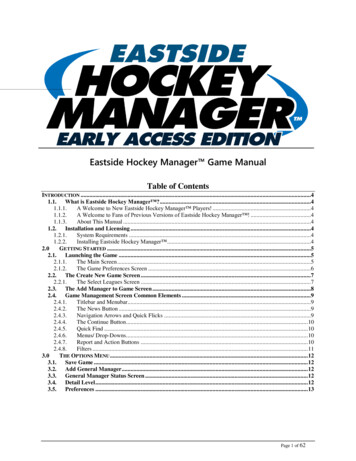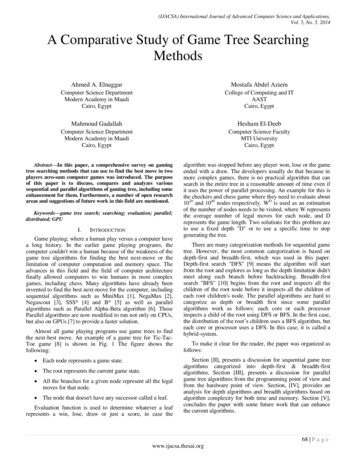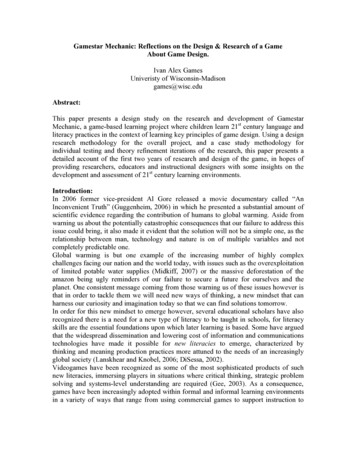
Transcription
IoT Solution WhitepaperW H I T E PA P E R , M A RC H 2 0 1 9THEGAMECHANGERFOR THE INTERNET OF THINGS1
IoT Solution WhitepaperINTRODUCTIONThe Internet of Things (IoT) is rapidly creating new ecosystems, revealing new insights andefficiencies, and enabling a vast array of new services and business models. While headlinegrabbing IoT applications such as augmented reality or self-driving cars capture the imagination,many IoT use cases do not need to rely on high-performance wireless modules and low-latency,high-bandwidth connectivity.For Low Power Wide Area (LPWA) applications—such as smart metering, tracking of assets, and monitoring equipment—the keyrequirement is the ability to periodically exchange small amounts of data easily, reliably, and cost-effectively. Unlike most other existingmobile communications technologies, Narrowband IoT (NB-IoT) is optimized for these types of applications—making NB-IoT an idealnetwork technology for a broad array of IoT solutions.Billions of devicesUp to 100x more devices per cell(compared to GSM)12Low data volumeBidirectional, infrequent transmissionof low data volumes. Data rates avgthroughput of 60bps1Low energy consumptionUp to 10 years of battery-poweredoperation2Deep indoor penetration 20 dB link budget (comparedto GSM)Dependent on network utilization and signal strengthAssuming equivalent of 2 AA batteries and typical traffic patternPicture 1: NB-IoT’s core benefitsDesigned for massive IoTIn its 2016 Release 13 standards, the 3rdGeneration Partnership Project (3GPP), aworldwide alliance of telecommunicationscompanies and partners, published a seriesof innovative cellular technologies optimizedfor IoT. Among these 3GPP-defined standardsis Narrowband IoT, a genuine game changerfor IoT solution providers that expands thetechnical possibilities and makes massive IoTdeployments economically feasible.NB-IoT utilizes LTE network operators’existing assets, such as sites, base stations,antennae, backhaul, and licensed spectrum.These licensed bands can handle a massivenumber of devices while remaining stableand avoiding interference. In contrast, datatransmission on unlicensed bands is likelyto deteriorate as the number of connecteddevices increases.Catering to the low-bandwidth requirementsof many IoT use cases in industrial,public, and consumer domains, NB-IoT’sadvantages include lower costs, reducedpower consumption, and deeper indoorcoverage. Based on a global industrystandard and operated within licensedspectrum, NB-IoT also addresses customers’needs for international operations, stability,reliability, security, cost-effectiveness, andhigh scalability. As part of its commitmentto accelerating IoT innovation, T-Mobiledeployed the first nationwide Narrowbandnetwork in the US in summer 2018.2
IoT Solution WhitepaperLPWA: DIFFERENT NETWORKSFOR DIFFERENT PURPOSESLong Term Evolution for Machines (LTE-M),also called LTE Cat-M1, Cat-M, or eMTC, isanother 3GPP-defined LPWA standard. LikeNB-IoT, it serves as an extension of the currentLTE standard, but it can transmit higher datarates than NB-IoT. While LTE-M requiressignificantly more spectrum bandwidth,and LTE-M radio modules are typically morecomplex and costlier than NB-IoT modules.While LPWAN includes technologies such asNB-IoT and Cat-M, LTE Category 1 devices(LTE Cat 1) are not part of this classificationand were originally defined as part of the3GPP Release 10. LTE Cat 1 is a technologywell suited for applications requiring voiceservices while also supporting the key featuresrequired for IoT devices typically associatedwith NB-IoT. NB-IoT and Cat 1 technologiescomplement each other by meeting thedifferent needs of diverse IoT use cases.There are also other commercially availablewireless communication modules forconnecting to GSM, 3G, or LTE mobilenetworks. These modules support a widerange of services, many of which are notrequired for IoT use cases, which drives upthe average hardware cost. Plus, as neither ofthese networks nor the devices are designedfor energy saving, they lack the long batterylife of NB-IoT devices. Finally, as a globalindustry standard, NB-IoT benefits froma large ecosystem of chipset and devicemanufacturers, which ultimately lowers costsand reduces the risk of vendor lock-in fromproprietary technologies.LTE LicensedUnlicensedUnlicensedBandwidth20 MHz1.4 MHz180 KHz125-500KHz200 KHzBiodirectional DataTransferFull DuplexHalf Duplex & Full DuplexHalf DuplexHalf DuplexHalf DuplexPeak Data Rate10 Mbps (DL)5 Mbps (UL)1 Mbps (DL)1 Mbps (UL)250 Kbps (DL)230 Kbps (UL)50 Kbps (DL)50 Kbps (UL)0,6 Mbps (DL)0,1 Mbps (UL) 200 B 24 B 200 kB 1,64 kBTypical Downlink DailyThroughputTypical Uplink DailyThroughputLimited only by battery power, radio signaling condition and commercial terms(e.g. monthly data volume, amount of messages/size per period)Max Coupling (vs. GSM)144 dB(0 dB)156 dB( 12 dB)164 dB( 20 dB)157 dB( 13 dB)153 dB( 9 dB)Expected Module Cost 10 10 5 7 3 Epected Max. BatteryLifetime13-5 Years5-10 Years10 Years10 Years10 Years1Assuming typical traffic pattern and battery sizeTable 1: Overview of IoT transmission technologies3
IoT Solution WhitepaperNB-IoT – THE TECHNOLOGYThe only thing narrow about NB-IoT is the bandwidth it uses. It enables an incrediblybroad range of new IoT applications. NB-IoT is based on proven LTE technology,with the LTE features that are unnecessary for LPWA IoT stripped out. Due to this,NB-IoT provides unique advantages that other technologies like 2G, 3G, or LTEcannot achieve or could only do at greater cost.Long battery lifeOne of the largest benefits of NB-IoT is the ability for modules to operate forseveral years on a battery charge. NB-IoT chipsets are optimized for low powerconsumption—focusing only on radio features relevant to the devices used.Signaling and overhead are reduced so that data is transferred more efficientlydirectly over the control plane—a feature referred to as Data over Non-AccessStratum (DoNAS).Moreover, key 3GPP features such as Power Saving Mode (PSM) put modules intoa sleep mode with very low energy consumption while sending occasional trackingarea update (TAU) messages to keep them registered at the network and avoid theneed to reregister upon wake-up. This long periodic TAU feature allows modulesto extend the duration between these tracking messages up to several weeks,enabling very long sleep intervals. In addition, NB-IoT’s Extended DiscontinuousReception (eDRX) feature offers a longer low-power paging mode that allowsdevices to receive downlink data from the server, without sending uplink data,helping to further conserve battery life.Superior indoor coverageWhile other mobile communication technologies offer excellent outdoor coverage,their reception deep within buildings or underground is often limited. Manyindustrial, enterprise, and municipal IoT use cases require reliable coverage insidebuildings, underground, or inside other enclosures.NB-IoT achieves deeper indoor coverage by concentrating radio transmissions intoa narrow 180 kHz carrier bandwidth. Additionally, its Coverage Enhancement (CE)feature offers the capability to repeat the transmission of a message if needed ata lower data rate. Proprietary technologies operating on unlicensed spectrum, incontrast, are legally limited in the number of repetitions (due to prescribed dutycycles), which impedes effective indoor coverage. Plus, sensors incapable of widearea communication require the setup of local gateways and greater ongoingmaintenance of peripheral networks.THETHREEPILLARSOF PERFORMANCEThe technical performanceof NB-IoT devices areinfluenced by three factors:1Coverage condition: Where is thedevice located? (E.g., deep withina building, underground, etc.) Theanswer indicates whether CE level 0,1, or 2 is required.2Traffic profile: How often should theIoT device send data to the server?How large is the average uplink anddownlink traffic payload?3Battery lifetime: How long shouldthe battery be able to power thedevice without maintenance? Whattype of battery is required?These factors are interdependent and,depending on which of them is the mostimportant for an application, users haveto accept concessions on the others.For example, an IoT device locateddeep within the basement of a building(assuming CE level 2) that needs tosend numerous messages per hour willlikely consume more power, resulting inshorter battery life.Low module costsT-Mobile has reached the industry-specified cost target of less than USD 5 per NBIoT module. This was achieved through strategic partnerships with module vendorsand by eliminating a range of unnecessary LTE features. Without the need tosupport carrier aggregation, voice, multistream transmissions, parallel processing,connected mode mobility measurements, turbo decoders, and inter- and intra-RAThandovers, the NB-IoT modules are produced more cost-effectively than regularLTE, 3G, or GSM modules.4
IoT Solution WhitepaperThe NB-IoT networkflexible and adaptable to different regionalnetwork implementations (e.g., stand-alone,guard band, or in-band operation).Since NB-IoT is based on LTE, it can easilyintegrate into existing LTE infrastructures.Most of the time, operators are able todeploy it on their LTE radio access networkthrough software upgrades. In addition,core network elements such as the CellularServing Gateway Node (C-SGN) and a fewcomponents specified by the 3GPP for NBIoT also need to be set up. NB-IoT can bedeployed both in the GSM and LTE spectrumwith no additional spectrum licensesrequired. It supports different spectraloperation modes, making its deploymentIPNon-IP: If possible, non-IP-based datatransmission is recommended for NB-IoTbecause it reduces the transmitted datavolume and saves overhead. Data is thenforwarded by the network to the applicationvia IP. Plus, since data can only be sent toone target IP address (server), this methodfurther increases the security of the device byreducing the risk of fraud.There are two possibilities for datatransmission between Narrowband IoTdevices and application servers:IP: Depending on the capabilities of theradio module and the operator, IPv4 andIPv6 are supported. UDP is the commonand recommended transport protocol forthis. As specified in the 3GPP standard,TCP is supported for NB-IoT, but it’s notrecommended due to the resulting higherdata volume. Likewise with HTTP andBasestationAirinterfaceNB-IoTdeviceHTTPS since they rely on TCP and demandadditional data volume for their overhead.In all cases, application protocols like MQTT,CoAP, LwM2M, and oneM2M can be used.C-SGNSCEFInternet/IP-VPNCharging r, Modem, SIMPayloadIP headerInternet/ERP systemIP to IP28B (IPv4)/48B (IPv6)NON-IPApplicationserver(s)Several target IPaddresses supportedCharging recordPayloadSignalingheaderSensor, Modem, SIMPayloadIP headerInternet/ERP systemNon-IP to IPNon-IP Data Delivery (NIDD)Figure 1: Data transmission on a NB-IoT networkOnly one target IPaddresse supported5
IoT Solution WhitepaperSECURE ON ALL LEVELSOverall, Narrowband IoT provides higher security than proprietary technologies, as itsprotection measures cover all aspects, from the UICC in the device to the applicationservers. By utilizing specific NB-IoT radio modules or chipsets and SIM cards, NB-IoTdevices also feature LTE-like security. Plus, being a global industry standard, NB-IoT(like LTE) benefits from a large international ecosystem of vendors and other experts toconstantly review and enhance security functions and algorithms as new threats arise.Integrity and authentication: When accessing the NB-IoT network, both the identitiesof the subscriber (device) and the network are verified. This mutual authenticationis done via the SIM card, on which sensitive credentials and subscriber data arestored and protected against unauthorized access. Integrity of the transmitted datais ensured by means of a specially generated key, independent of the encryptionfunction. To increase the security level, NB-IoT uses longer encryption keys (128 to256 bits) than many technologies. Manipulation of data is reliably detectable by thedevice and the C-SGN.Confidentiality: User data is encrypted between the NB-IoT modem and the corenetwork using a separately generated key and algorithm. Between the core network(C-SGN) and the application server, data traffic is protected via an IPsec tunnel, sothe device cannot be reached from the internet. Furthermore, the user can choose toencrypt or hash the data end to end from the client application on the device up to theserver or ERP system.NB-IoT IS NOWIn 2017, T-Mobile began NB-IoT trials with scaled deployments throughout the year,then launched the first nationwide NB-IoT network in the US in summer 2018. It operateswherever T-Mobile’s existing LTE networks are, benefiting from a proven infrastructureand decades of mobile network operating experience. Its C-SGN is geo-redundant for highavailability, and redundant connections from the core network to the application server arealso possible, further enhancing availability. T-Mobile also launched geo-redundant, highlyavailable SCEF for non-IP traffic.In addition to C-SGN and SCEF, T-Mobile has introduced a fully capable SCS node as anIoT enabler that will allow application servers to connect seamlessly to its core networkacross technologies or transport. T-Mobile SCS provides functionalities like devicemanagement, data collection, and data management, in addition to secure serviceexposure to application partners.T-Mobile enables customers, partners, and other interested parties to easily startexploring the possibilities of NB-IoT. CONNECT, T-Mobile’s IoT partner program, isbuilding a best-of-breed ecosystem of innovators to help accelerate IoT success forsolution and hardware providers, system integrators, resellers, and others. CONNECTprovides the support and connections to help partners accelerate time to market forIoT solutions while gaining exposure and reducing their risk. In addition, T-Mobilehas partnered with Twilio to give developers the network connectivity, platform,APIs, and tools to bring game-changing Narrowband IoT solutions to market. To helpwholesale partners, such as resellers, connect and accelerate time to market fornew IoT solutions, T-Mobile has a number of network-certified radio modules that areready to use on T-Mobile’s Narrowband network. Plus, it has a streamlined process forcertifying new devices.6
IoT Solution WhitepaperNB-IoT USE CASESWhile exciting applications such asaugmented reality and autonomous drivinggenerate hype for the IoT future, there areinnumerable LPWA IoT use cases that areperfectly suited for the low costs, low powerconsumption, and deep indoor coverage thatNB-IoT offers today.NB-IoT addresses use cases and applicationsthat previously could not be servedefficiently by available networks andtechnologies. Now, enterprises are not onlyable to increase the efficiency of existing IoTapplications, but they can also tap into newmarkets and develop entirely new productsand services. Opportunities abound for usecases and applications that require onlyperiodic exchanges of data, where the abilityto cost-effectively monitor, control, andcapture data from remote devices and thingswill increase efficiency, provide valuableinsights, and deliver rapid ROI.1Notable examples are found throughoututilities, logistics, manufacturing,consumer and agriculture, as well as manyapplications that enable the smart cites andbuildings. Real-world IoT solutions that arerevolutionizing things today include:Asset tracking:Smart buildings:NB-IoT solutions help enterprisesimprove efficiency, optimize logistics,and gain deeper insights into theiroperations with solutions that trackassets in near-real time. Customersare using T-Mobile’s NB-IoT networkto improve loss prevention, item-levelmonitoring, and cold-chain monitoring.Connecting innovative IoT solutionsfor building access, HVAC controls,resource monitoring, and predicativemaintenance, NB-IoT helps maximizethe comfort and safety of buildingoccupants while minimizing energy andresource use.Fleet:Smart cities:T-Mobile’s nationwide NB-IoTnetwork gives fleet operators thedata they need to cut vehicle costs,make better routing decisions, enablepredictive maintenance, and improvedriver productivity.From environmental monitoring to publicsafety, NB-IoT is the ideal network for abroad range of innovative, cost-effectiveIoT solutions that help municipalitiesimprove livability, safety, and efficiency.7
IoT Solution WhitepaperOUTLOOKT-Mobile’s NB-IoT network expansion acrossthe US is enabling commercial introductionof new, innovative, and cost-effective NB-IoTservices from coast to coast. As more NB-IoTdevices and modules are developed andcertified, the array of IoT solutions for noveluse cases and business models will continueto expand.Moreover, the June 2017 release of the3GPP specification Release 14 establishedadditional standards that further improve NBIoT. Among other technical enhancements,the new release supports single-cell multicast,enhanced device positioning, reducedlatency, and improved power consumption(14 dBm output power reduction to enablefurther module cost savings). Release 15 in2018 includes additional enhancements thathelp further minimize battery consumption.The technical specifications of Releases14 and 15 will gradually be integrated intonetwork components, chipsets, and modulesaccording to their usual developmentcycles—further improving NB-IoT technology.T-Mobile’s NB-IoT technology integratesRelease 14 and 15 enhancements such as idlemode interfrequency mobility, idle-mode loaddistribution, and higher transport block size(2,535 bytes).Even as the revolutionary new possibilitiesof 5G technology come to market, NB-IoTwill play an important and growing role in theevolution of the IoT network landscape. Formassive IoT applications and LPWA use cases,NB-IoT is a crucial technological innovationthat unlocks the door for the next generationof IoT architectures and game-changingservices—today.1. Worldwide roaming not yet available.Coverage not available in some areas. T-Mobile and the magenta color are registered trademarks of Deutsche Telekom AG. 2019 T-Mobile USA, Inc.8
T-Mobile also launched geo-redundant, highly available SCEF for non-IP traffic. In addition to C-SGN and SCEF, T-Mobile has introduced a fully capable SCS node as an IoT enabler that will allow application servers to connect seamlessly to its core network across technologies or transport. T-Mobile SCS provides functionalities like device











